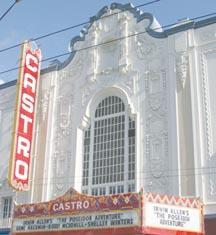
The Castro District of San Francisco has found itself thrust into the national spotlight by recent events. With the premiere of Gus Van Sant’s “Milk” across the country and the continuing controversy over Proposition 8, the neighborhood so instrumental in the gay rights movement is receiving a new surge of attention – and more importantly respect – for its rich history. Yet the Castro is not a museum district; it is a living, breathing neighborhood that is changing and facing significant challenges in a down economy.
Clearly the area has not lost its huge symbolic political role. The brouhaha over the passage of Proposition 8 – which barred gay marriage in California – sparked marches and protests. To many it appears that the battle that began with Harvey Milk all those years ago has just entered a new phase that many Castro residents are anxious to continue.
Situated in the heart of the city, just east of Twin Peaks – a large golden hill which beats back the fog from the neighborhood – the Castro is beloved for its colorful Victorians, vintage European streetcars, and eclectic shops and restaurants. It is the site of Harvey Milk’s famous camera shop. The triumphs (and recent setbacks) of the gay rights movement are on display at the large LGBT Center at Octavia and Market streets and in a new small exhibition, “Passionate Struggle,” that was just opened by the GLBT Historical Society at 18th and Castro streets (in one of its last acts, the space for the exhibition was donated by Washington Mutual for a year).
The neighborhood has been changing in recent years – shopkeepers report a surge in strollers in the neighborhood. Professional couples and their children who may not be able to land a place in Noe Valley over the hill (aka “Stroller Valley”) have slowly been moving into the “gayborhood” (as it is affectionately called). Tour buses have been stopping at the busy intersection of 18th and Castro streets where tourists have been known to get out and, not always out of respectful curiosity, snap photos of two men holding hands to show their aunt in Peoria.
Local merchants are hoping that all this recent attention can translate to the bottom line (I challenge someone to find an area of a large American city with more neighborhood and merchant groups than the Castro). Though known for technology, tourism is one of the largest industries in San Francisco and business has been lackluster of late. A huge vacancy where Tower Records used to sit at Market and Noe streets still lies empty after nearly two years. The building used to house a large Finnish baths when the area was populated by so many Norwegians, Swedes and Finns it was known as “Little Scandinavia.” One retailer, All American Boy, recently closed its doors after 32 years, and Suri – one of my favorite restaurants – will close for good on December 6th.
Although the neighborhood has successfully positioned itself as the historical home of the LGBT community, many wonder if that legacy will be continued by a younger generation of gays who came out in a more tolerant era. They may take for granted what was fought and even died for by Harvey Milk and many others.
Talk to longtime Castro residents and you hear concern in their voices that the neighborhood has lost its knack for experimentation and zaniness. The nearby Mission and South of Market districts now appear more triumphant in terms of “edginess” – a quality that is so important to San Franciscans’ identity. A friend of mine surprised me when he told me that he much preferred the gay culture in his home city of Atlanta over the Castro. The bars, he explained, were “more happening” than those here.
Today many younger gays often prefer to venture to the city’s uberhip South of Market district where the bars and clubs are larger. Many complain about the narrow and sometimes dirty sidewalks as well as the lack of a large public space in the neighborhood.
Of course, the neighborhood does not always feel as modern in its look as the glass towers South of Market. But still the Castro continues to be a busy area with numerous cultural events, including the neighborhood’s greatest resource, the peerlessly beautiful Castro Theatre which showcases so many great festivals throughout the year. With numerous events, parties and festivals year-round, the Castro has retained much of its original flair and taste for experimentation even as gay culture and the economy have changed. “Milk,” and Sean Penn’s amazing performance, do not only testify to this historical iconoclasm but speak of its staying power.
Andy Sywak is the publisher of the Castro Courier neighborhood newspaper.












